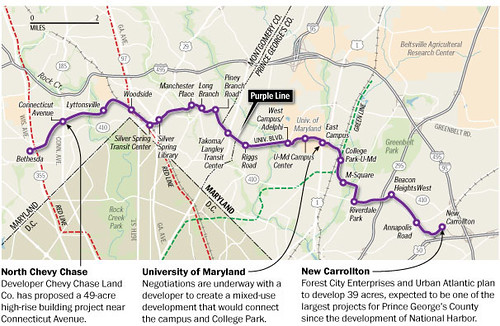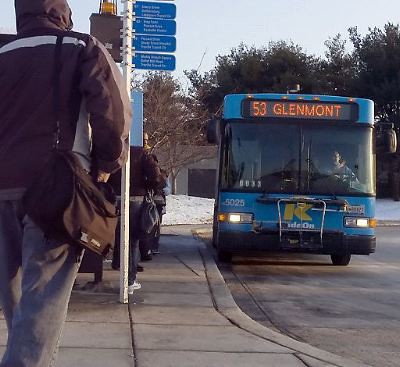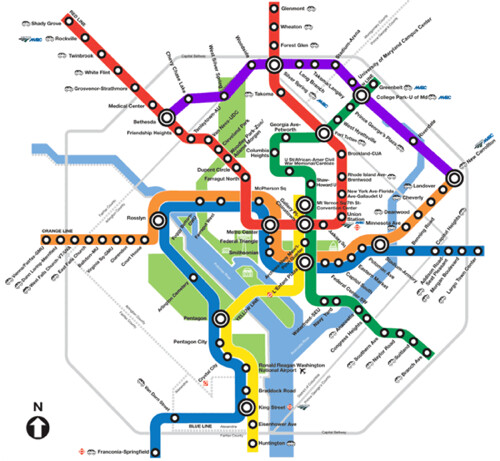Setting the stage for the Purple Line light rail line to be an overwhelming success Part 1 | simultaneously introduce improvements to other elements of the transit network
=====
Part 1: the principles
Part 2 | the program (macro changes)
Part 3 | influences
Part 4 | Making over New Carrollton as a transit-centric urban center and Prince George's County's "New Downtown"
Part 5 | Fenton Street, East-West Highway, and Wayne Avenue, Silver Spring, as building blocks for a Silver Spring "Sustainable Mobility District"
-- Part 1: Setting the stage
-- Part 2: Program items 1- 9
-- Part 3: Program items 10-18
-- Part 4: Conclusion
Part 6 | Creating a transportation development authority in Montgomery and Prince George's County to effectuate placemaking, retail development, and housing programs in association with the Purple Line
Part 7 | Using the Purple Line to rebrand Montgomery and Prince George's Counties as Design Forward
=====
Past entries on the Purple Line include:
-- "To build the Purple Line, perhaps Montgomery and Prince George's Counties will have to create a "Transportation Renewal District" and Development Authority," 2015
-- "Purple line planning in suburban Maryland as an opportunity to integrate place and people focused initiatives into delivery of new transit systems," 2014
-- "Quick follow up to the Purple Line piece about creating a Transportation Renewal District and selling bonds to fund equitable development," 2014
-- "Inner ring suburban community improvement," 2014
-- "Maybe the Purple Line light rail project in Suburban Maryland is a lot bigger deal than is recognized (It's our Crossrail)," 2016
Despite the Purple Line light rail line slated for Montgomery and Prince George's Counties in Suburban Maryland being declared one of the most important infrastructure projects in the US ("Trump Administration Infrastructure Program Priority List: Part One, the list"), the proposed FY2018 Federal Budget proposes not funding a number of transit projects already in the pipeline, and the list of projects includes the Purple Line.

Washington Post graphic.
GGW has a piece about it ("The Purple Line is toast if Trump's budget passes") and the comment thread attracted some people who are still rabidly against the line, repeating the same tiresome arguments of greedy developers, no one will ride it, the trail it will complement is more important than transit + trail, etc.
I wrote a couple comments, including one that I have expanded into this set of blog entries.
======
The arguments that the PL will be unsuccessful are pretty fatuous. Recognizing the current failures in WMATA are man-made not inherent to the "technology" of mass transit, and WMATA's problems are correctable in the long term (even if I have my doubts), the belief that the PL won't have many riders is foolish.
The Washington metropolitan area has a history of success with rail service--mostly with subway but the area is served by regional commuter railroads also--people have a familiarity with transit and know how to use transit and rail systems specifically, and there is no reason that the Purple Line will be an exception.
Even with the fall off in the use of Metrorail and Metrobus, transit moves many hundreds of thousands of people to and from work and other destinations each workday in the DC area.
 RideOn bus 53, Glenmont Metrorail Station, Montgomery County, Maryland. Photo: Chris Rossi, The Gazette.
RideOn bus 53, Glenmont Metrorail Station, Montgomery County, Maryland. Photo: Chris Rossi, The Gazette.Until the recent fall off in system ridership because of system failures, the Metrorail transit system was the second most successful subway system in the US.
Furthermore, Montgomery County's RideOn bus system is one of the most successful suburban bus systems in the US ("Suburbs spurning Metrobus service," Washington Post, 1981), although it too has seen declines in ridership since the Great Recession.
★ The Purple Line adds significant value to people seeking to move in the east-west direction within Suburban Maryland and between Metrorail lines by freeing them from having to go to DC to make the transfer between lines (past blog entry, "Maybe the Purple Line light rail project in Suburban Maryland is a lot bigger deal than is recognized (It's our Crossrail);" "Connecting the suburban dots," Governing Magazine, 2003)
★ the corridor already has significant transit ridership, yes, some will shift to rail but that's a good thing as rail is more reliable, more comfortable, faster, and cheaper on a per ride subsidy basis.
★ The PL will connect to four legs (two red, one green, one orange) of the Metrorail system, and to all three MARC railroad lines (Brunswick, Camden, Penn)
★ The PL will leverage Montgomery County's Ride On bus system, as mentioned, one of the most successful suburban bus systems in the US.
★ MoCo is adding to the RideOn system's utility by creating a high frequency BRT network.
★ Plus, by reducing the need to travel into the city to transfer to reach another suburban location, the Purple Line will add capacity to the Metrorail system and should contribute to system throughput improvements.
My sense is that from Day 1, the Purple Line will be the most successful single light rail line in the US, in terms of daily ridership.
By that I mean it will have 50,000 to 70,000 daily riders, putting its ridership ahead of any other single light rail line in the US.
As it is, while the Dallas light rail system is touted as a great success, it has about 100,000 daily riders on four lines.
By contrast, the Metrorail system still moves about 600,000 people daily and can move one million people or more for special events like the Women's March ("More than 1 million Metro trips taken for Women's March," WUSA9-TV) even in its current sputtering condition.

This is an old image composition produced by the Coalition for Smarter Growth showing the Pre-Silver Line WMATA map with a form of the Purple Line added. As currently planned, the Purple Line will have more stations than are shown here.
It is rare in the US to integrate light rail into a strong subway network, but Paris has done it on its outskirts, and the Docklands Light Railway system in London is another example, where they used existing trackway and converted it into a light rail system, complementing the city's subway, railroad, and bus transit network. Both the Paris trams and the DLR are integrated into their respective region's transit planning, marketing, and fare media systems.
In keeping with two running themes in this blog concerning area transit service:
1. We don't have a system of integrated and comprehensive transit services in the Washington area which disserves riders significantly, increases congestion, and promotes sprawl and automobility ("Without the right transportation planning framework, metropolitan areas are screwed, and that includes the DC area," "Route 7 BRT proposal communicates the reality that the DC area doesn't adequately conduct transportation planning at the metropolitan-scale," and "Will buses ever be cool? Boston versus the Raleigh-Durham's GoTransit Model")

From the presentation, "Metropolitan Mass Transit Planning: Towards a Hierarchical and Conceptual Framework."
2. We need to move away from a discoordinated set of transit agencies and beyond the WMATA Compact, separating planning from operations, rectifying funding problems, but tightly integrating services across the transit network, along the lines of how transit is planned and operated in Germany, within coordinating bodies called "transport associations"--Verkehrsverbunds ("The answer is: Create a single multi-state/regional multi-modal transit planning, management, and operations authority association")
Photo from the East MoCo blog showing PL promotional signage at the Silver Spring Library.
The Purple Line is an opportunity that can be seized as "a significant event" to reboot/bring about changes across the transit network in transit service planning, management, coordination, implementation and quality at the metropolitan and regional scales.
The idea is to implement and coordinate other changes across the transit network that would add value to and leverage the Purple Line and better integrate it into the transit network.
The idea would be to implement the changes simultaneously with the opening of the Purple Line, which is currently set for 2022 (but which will probably be delayed because of the current funding uncertainties and pending lawsuits).
Part 2 lists the big changes that could be done (although some would take more than 5 years, most wouldn't) to begin to lay the framework for a truly integrated Washington metropolitan and regional transit network.
Labels: busways/transitways, change-innovation-transformation, fixed rail transit service, public realm framework, transit, transit marketing, transportation planning, urban design/placemaking





0 Comments:
Post a Comment
<< Home